Abstract
When 32 antibody-free ferrets were inoculated with the highly mink-virulent Utah-1 strain of Aleutian disease virus (ADV), most developed ADV antibody starting 15 days after infection, but the antibody titers were much lower than those seen in mink. Relatively small amounts of ADV were demonstrated in CRFK cell culture, using ferret spleen and lymph node homogenates only 4 to 10 days after experimental infection, but low-level viral persistence for 180 days was shown by mink inoculation. The ferrets inoculated with the Utah-1 strain of ADV did not develop elevated gamma globulin levels, but did have mild tissue lesions. Forty-two percent of a group of 214, approximately 1-year-old, recently pregnant, female ferrets were found to have antibody to ADV. An analysis of the serum proteins of the ferrets with ADV antibody showed that they had a significant, but mild, elevation of their serum gamma globulin. Serial ferret-to-ferret transmission of a ferret strain of ADV by inoculation of spleen homogenates was demonstrated, and some of these ferrets developed liver lesions. Mink inoculated with ferret ADV made antibody, but did not develop hypergammaglobulinemia or tissue lesions. Although both ferret and mink strains of ADV replicate and persist in the ferret, they fail to cause severe disease of the type usually seen in the closely related mink. Mink and ferret ADV strains appear to be biologically distinct.
Full text
PDF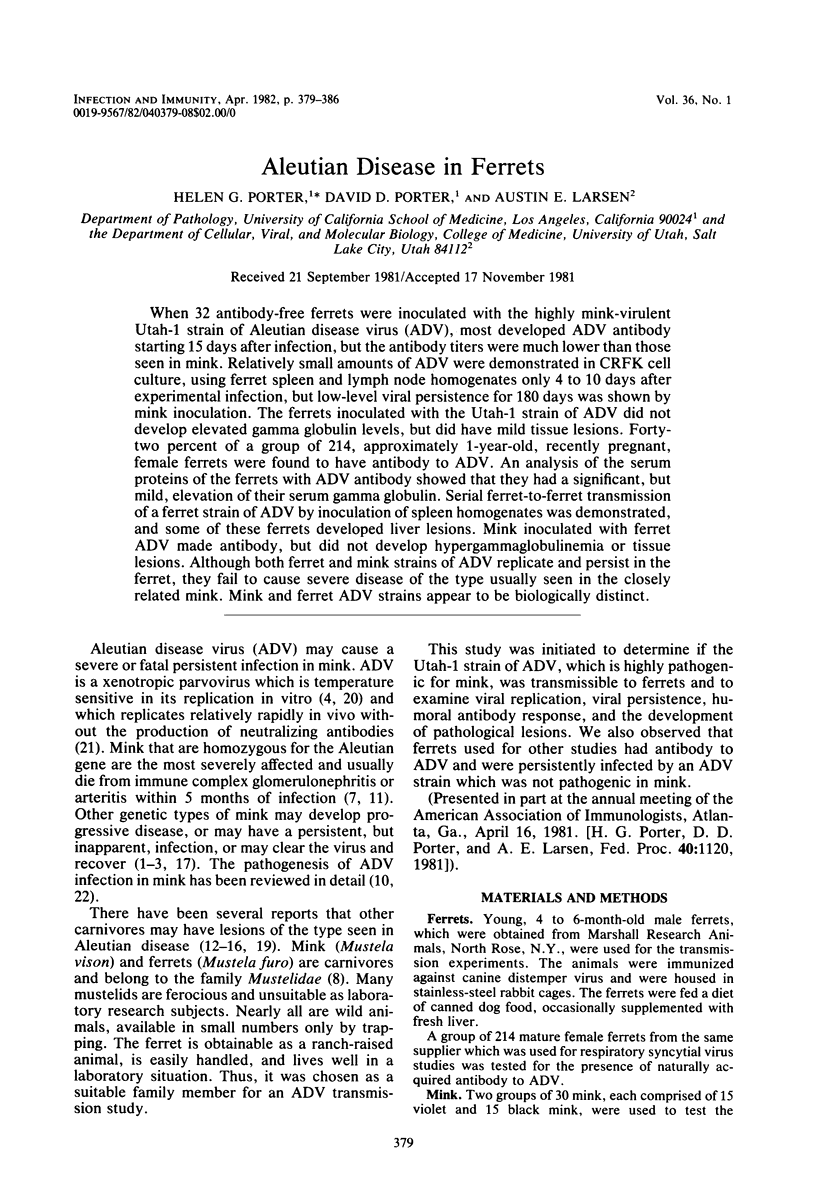
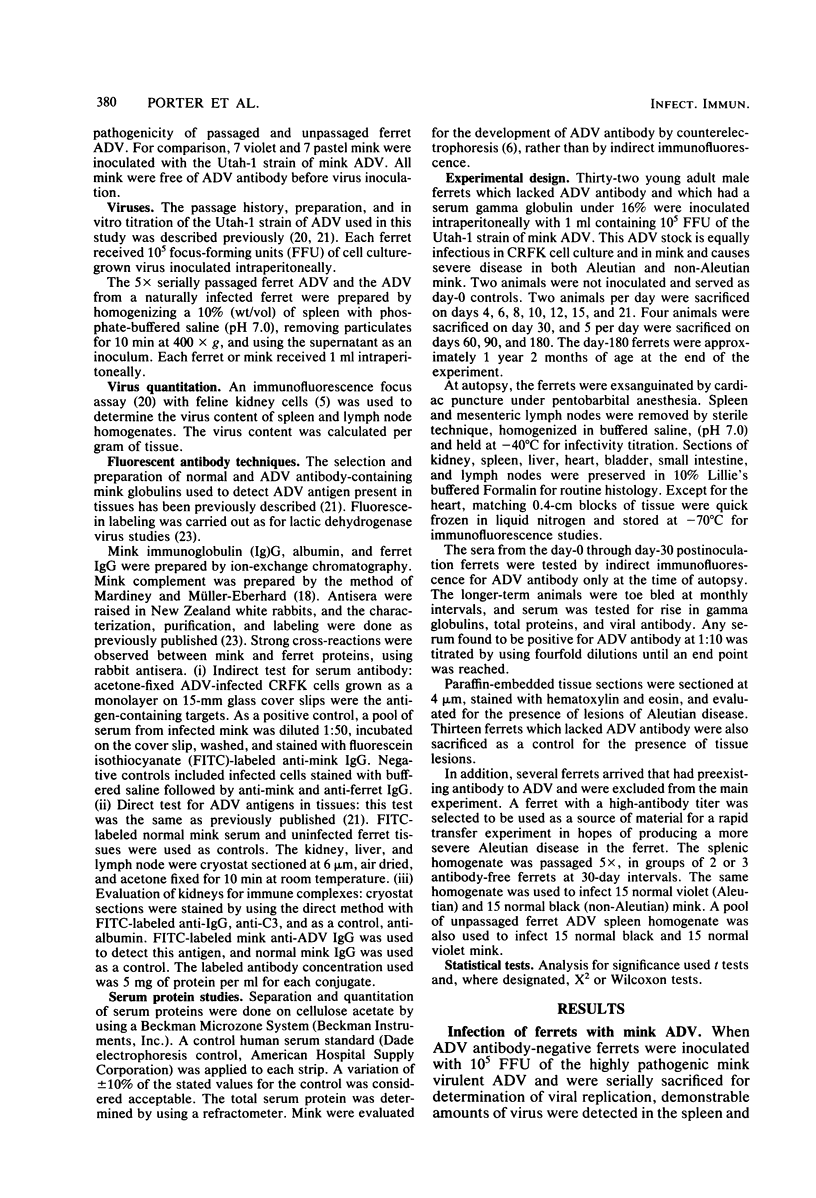
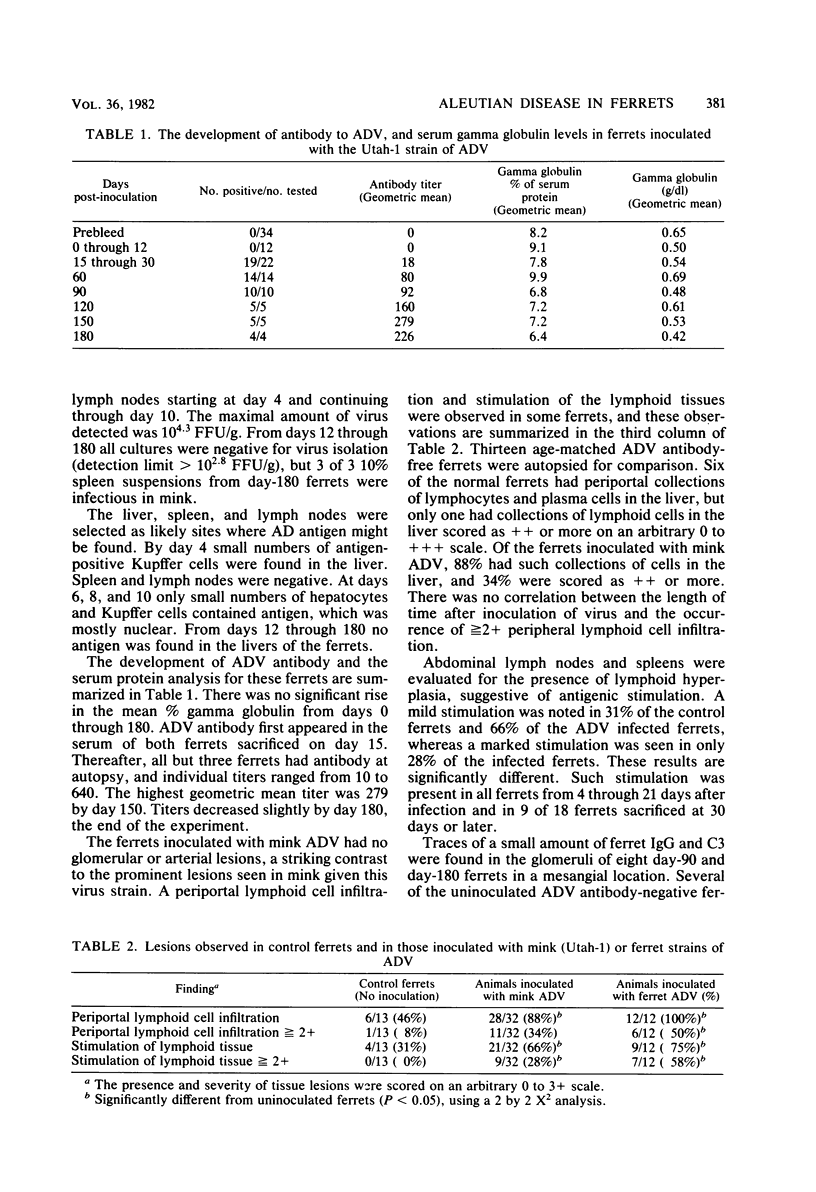

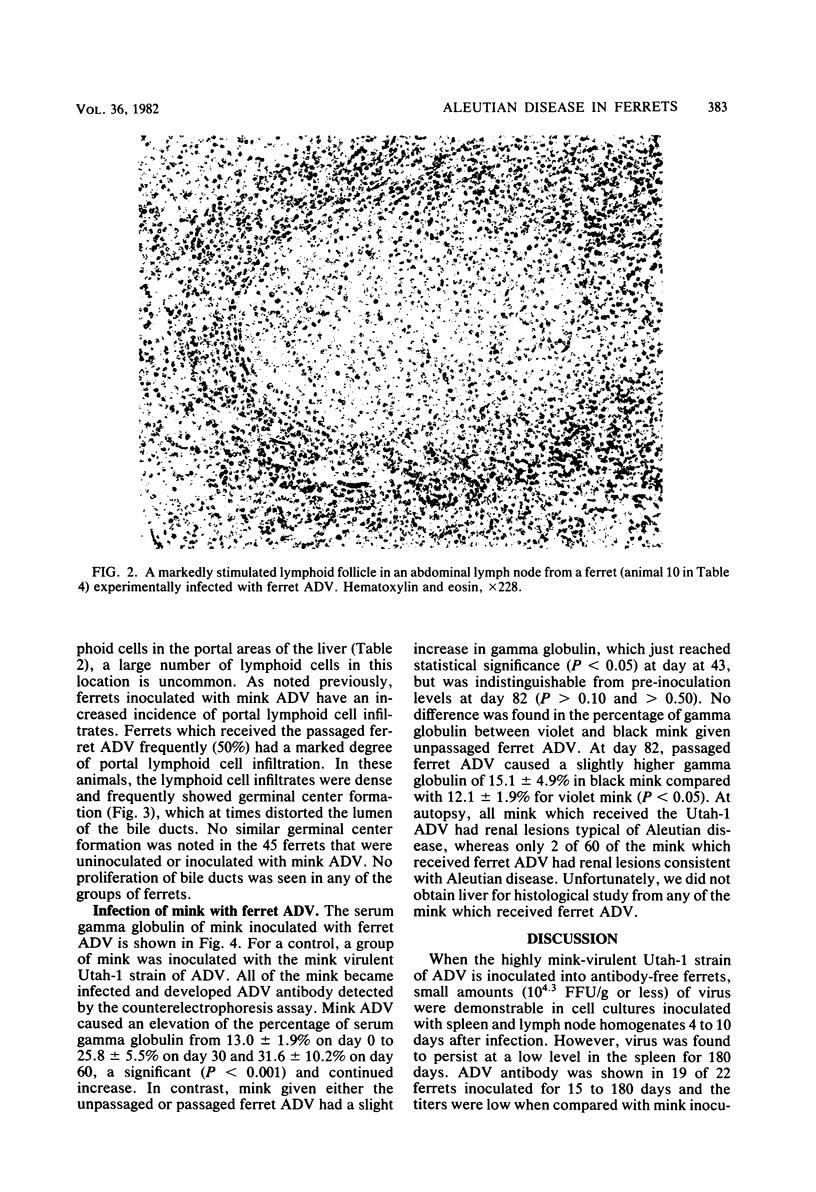


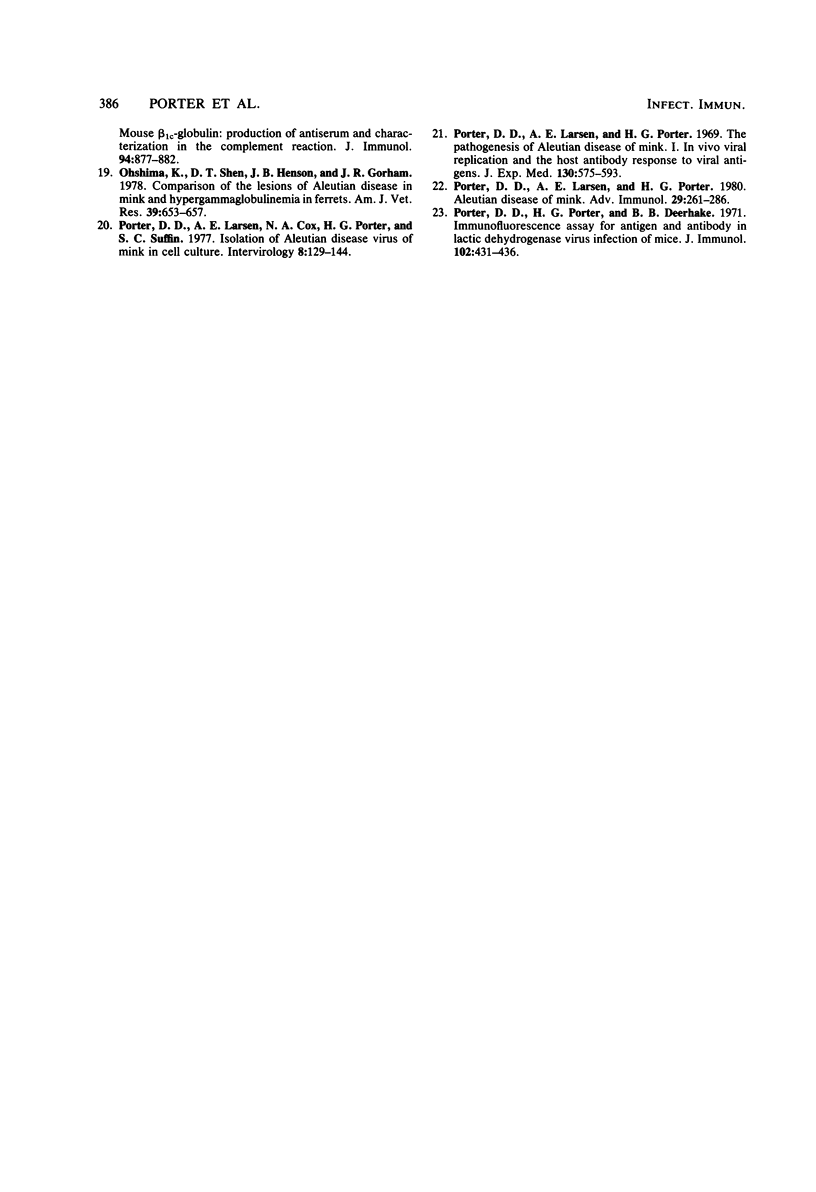
Images in this article
Selected References
These references are in PubMed. This may not be the complete list of references from this article.
- An S. H., DePauli F. J., Wright P., Ingram D. G. Characteristics of inapparent Aleutian disease virus infection in mink. Res Vet Sci. 1978 Mar;24(2):200–204. [PubMed] [Google Scholar]
- An S. H., Ingram D. G. Detection of inapparent Aleutian disease virus infection in mink. Am J Vet Res. 1977 Oct;38(10):1619–1624. [PubMed] [Google Scholar]
- An S. H., Ingram D. G. Transmission of Aleutian disease from mink with inapparent infections. Am J Vet Res. 1978 Feb;39(2):309–313. [PubMed] [Google Scholar]
- Bloom M. E., Race R. E., Wolfinbarger J. B. Characterization of Aleutian disease virus as a parvovirus. J Virol. 1980 Sep;35(3):836–843. doi: 10.1128/jvi.35.3.836-843.1980. [DOI] [PMC free article] [PubMed] [Google Scholar]
- Crandell R. A., Fabricant C. G., Nelson-Rees W. A. Development, characterization, and viral susceptibility of a feline (Felis catus) renal cell line (CRFK). In Vitro. 1973 Nov-Dec;9(3):176–185. doi: 10.1007/BF02618435. [DOI] [PubMed] [Google Scholar]
- Crawford T. B., McGuire T. C., Porter D. D., Cho H. J. A comparative study of detection methods for Aleutian disease viral antibody. J Immunol. 1977 Apr;118(4):1249–1251. [PubMed] [Google Scholar]
- Eklund C. M., Hadlow W. J., Kennedy R. C., Boyle C. C., Jackson T. A. Aleutian disease of mink: properties of the etiologic agent and the host responses. J Infect Dis. 1968 Dec;118(5):510–526. doi: 10.1093/infdis/118.5.510. [DOI] [PubMed] [Google Scholar]
- Gorham J. R., Henson J. B., Crawford T. B., Padgett G. A. The epizootiology of aleutian disease. Front Biol. 1976;44:135–158. [PubMed] [Google Scholar]
- Henson J. B., Gorham J. R., McGuire T. C., Crawford T. B. Pathology and pathogenesis of Aleutian disease. Front Biol. 1976;44:175–205. [PubMed] [Google Scholar]
- Ingram D. G., Cho H. J. Aleutian disease in mink: virology, immunology and pathogenesis. J Rheumatol. 1974 Mar;1(1):74–92. [PubMed] [Google Scholar]
- Kenyon A. J., Howard E., Buko L. Hypergammaglobulinemia in ferrets with lymphoproliferative lesions (Aleutian disease). Am J Vet Res. 1967 Jul;28(125):1167–1172. [PubMed] [Google Scholar]
- Kenyon A. J., Kenyon B. J., Hahn E. C. Protides of the Mustelidae: immunoresponse of mustelids to Aleutian mink disease virus. Am J Vet Res. 1978 Jun;39(6):1011–1015. [PubMed] [Google Scholar]
- Kenyon A. J., Williams R. C., Jr, Howard E. B. Monoclonal gamma-globulins in ferrets with lymphoproliferative lesions. Proc Soc Exp Biol Med. 1966 Nov;123(2):510–513. doi: 10.3181/00379727-123-31529. [DOI] [PubMed] [Google Scholar]
- Larsen A. E., Porter D. D. Pathogenesis of aleutian disease of mink: identification of nonpersistent infections. Infect Immun. 1975 Jan;11(1):92–94. doi: 10.1128/iai.11.1.92-94.1975. [DOI] [PMC free article] [PubMed] [Google Scholar]
- MARDINEY M. R., Jr, MUELLER-EBERHARD H. J. MOUSE BETA-1C-GLOBULIN: PRODUCTION OF ANTISERUM AND CHARACTERIZATION IN THE COMPLEMENT REACTION. J Immunol. 1965 Jun;94:877–882. [PubMed] [Google Scholar]
- Ohshima K., Shen D. T., Henson J. B., Gorham J. R. Comparison of the lesions of Aleutian disease in mink and hypergammaglobulinemia in ferrets. Am J Vet Res. 1978 Apr;39(4):653–657. [PubMed] [Google Scholar]
- Porter D. D., Larsen A. E., Cox N. A., Porter H. G., Suffin S. C. Isolation of Aleutian disease virus of mink in cell culture. Intervirology. 1977;8(3):129–144. doi: 10.1159/000148888. [DOI] [PubMed] [Google Scholar]
- Porter D. D., Larsen A. E., Porter H. G. Aleutian disease of mink. Adv Immunol. 1980;29:261–286. doi: 10.1016/s0065-2776(08)60046-2. [DOI] [PubMed] [Google Scholar]
- Porter D. D., Larsen A. E., Porter H. G. The pathogenesis of Aleutian disease of mink. I. In vivo viral replication and the host antibody response to viral antigen. J Exp Med. 1969 Sep 1;130(3):575–593. doi: 10.1084/jem.130.3.575. [DOI] [PMC free article] [PubMed] [Google Scholar]
- Porter D. D., Porter H. G., Deerhake B. B. Immunofluorescence assay for antigen and antibody in lactic dehydrogenase virus infection of mice. J Immunol. 1969 Feb;102(2):431–436. [PubMed] [Google Scholar]




